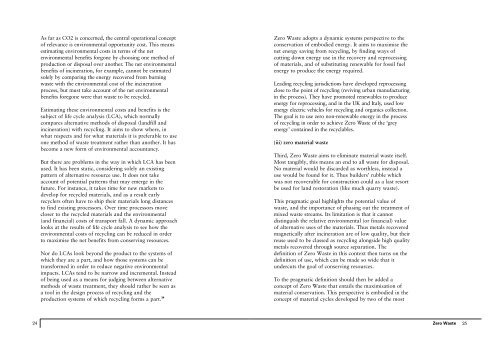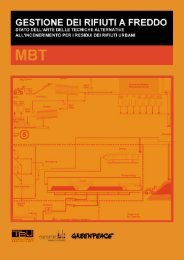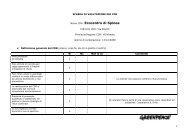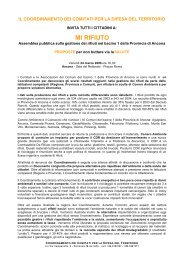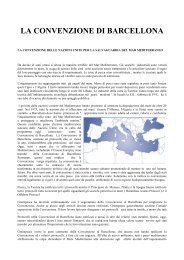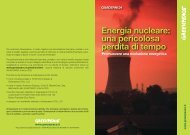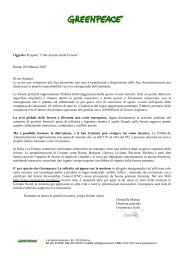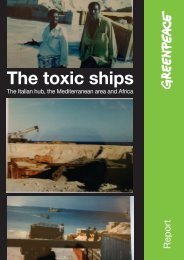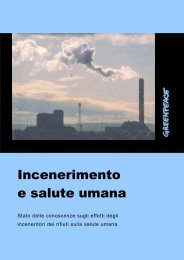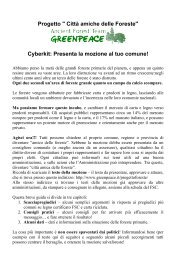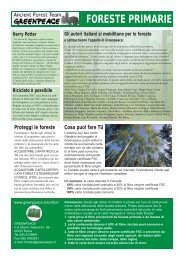Zero Waste by Robin Murray, Greenpeace Environmental Trust 2002
Zero Waste by Robin Murray, Greenpeace Environmental Trust 2002
Zero Waste by Robin Murray, Greenpeace Environmental Trust 2002
You also want an ePaper? Increase the reach of your titles
YUMPU automatically turns print PDFs into web optimized ePapers that Google loves.
As far as CO2 is concerned, the central operational concept<br />
of relevance is environmental opportunity cost. This means<br />
estimating environmental costs in terms of the net<br />
e n v i ronmental benefits forgone <strong>by</strong> choosing one method of<br />
p roduction or disposal over another. The net enviro n m e n t a l<br />
benefits of incineration, for example, cannot be estimated<br />
solely <strong>by</strong> comparing the energy re c o v e red from burn i n g<br />
waste with the environmental cost of the incineration<br />
p rocess, but must take account of the net enviro n m e n t a l<br />
benefits foregone were that waste to be recycled.<br />
Estimating these environmental costs and benefits is the<br />
subject of life cycle analysis (LCA), which normally<br />
compares alternative methods of disposal (landfill and<br />
incineration) with recycling. It aims to show where, in<br />
what respects and for what materials it is preferable to use<br />
one method of waste treatment rather than another. It has<br />
become a new form of environmental accountancy.<br />
But there are problems in the way in which LCA has been<br />
used. It has been static, considering solely an existing<br />
pattern of alternative resource use. It does not take<br />
account of potential patterns that may emerge in the<br />
future. For instance, it takes time for new markets to<br />
develop for recycled materials, and as a result early<br />
recyclers often have to ship their materials long distances<br />
to find existing processors. Over time processors move<br />
closer to the recycled materials and the environmental<br />
(and financial) costs of transport fall. A dynamic approach<br />
looks at the results of life cycle analysis to see how the<br />
environmental costs of recycling can be reduced in order<br />
to maximise the net benefits from conserving resources.<br />
Nor do LCAs look beyond the product to the systems of<br />
which they are a part, and how those systems can be<br />
transformed in order to reduce negative environmental<br />
impacts. LCAs tend to be narrow and incremental. Instead<br />
of being used as a means for judging between alternative<br />
methods of waste treatment, they should rather be seen as<br />
a tool in the design process of recycling and the<br />
production systems of which recycling forms a part. 34<br />
<strong>Zero</strong> <strong>Waste</strong> adopts a dynamic systems perspective to the<br />
conservation of embodied energy. It aims to maximise the<br />
net energy saving from recycling, <strong>by</strong> finding ways of<br />
cutting down energy use in the recovery and reprocessing<br />
of materials, and of substituting renewable for fossil fuel<br />
energy to produce the energy required.<br />
Leading recycling jurisdictions have developed re p ro c e s s i n g<br />
close to the point of recycling (reviving urban manufacturing<br />
in the process). They have promoted renewables to pro d u c e<br />
e n e rgy for re p rocessing, and in the UK and Italy, used low<br />
e n e rgy electric vehicles for recycling and organics collection.<br />
The goal is to use zero non-renewable energy in the pro c e s s<br />
of recycling in order to achieve <strong>Zero</strong> <strong>Waste</strong> of the ‘gre y<br />
e n e rgy’ contained in the recyclables.<br />
(iii) zero material waste<br />
Third, <strong>Zero</strong> <strong>Waste</strong> aims to eliminate material waste itself.<br />
Most tangibly, this means an end to all waste for disposal.<br />
No material would be discarded as worthless, instead a<br />
use would be found for it. Thus builders’ rubble which<br />
was not recoverable for construction could as a last resort<br />
be used for land restoration (like much quarry waste).<br />
This pragmatic goal highlights the potential value of<br />
waste, and the importance of phasing out the treatment of<br />
mixed waste streams. Its limitation is that it cannot<br />
distinguish the relative environmental (or financial) value<br />
of alternative uses of the materials. Thus metals recovered<br />
magnetically after incineration are of low quality, but their<br />
reuse used to be classed as recycling alongside high quality<br />
metals recovered through source separation. The<br />
definition of <strong>Zero</strong> <strong>Waste</strong> in this context then turns on the<br />
definition of use, which can be made so wide that it<br />
undercuts the goal of conserving resources.<br />
To the pragmatic definition should then be added a<br />
concept of <strong>Zero</strong> <strong>Waste</strong> that entails the maximisation of<br />
material conservation. This perspective is embodied in the<br />
concept of material cycles developed <strong>by</strong> two of the most<br />
24<br />
<strong>Zero</strong> <strong>Waste</strong><br />
25


